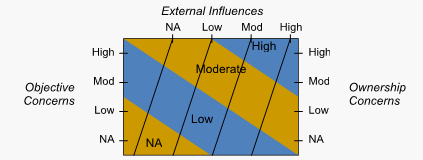Part 3: Socio/Political Concerns
Figure 1: Organization Guidance Image

See the Socio/Political Concerns Guidance for variable descriptions.
This bar chart summarizes inputs for the Relative Risk and Organization Assessments. Use it to inform decisions made regarding incident complexity and organization type.
Organization
Socio Political Concerns: Objective Concerns
Evaluate the complexity of the incident objectives and rank this element low, moderate, or high.
Considerations: Clarity; ability of current organization to accomplish; disagreement among cooperators; tactical/operational restrictions; complex objectives involving multiple focuses; objectives influenced by serious accidents or fatalities.
Socio/Political Concerns: External Influences
Evaluate the effect external influences will have on how the fire is managed and rank this element low, moderate, or high.
Considerations: Limited local resources available for initial attack; increasing media involvement, social/print/television media interest; controversial fire policy; threat to safety of visitors from fire and related operations; restrictions and/or closures in effect or being considered; pre-existing controversies/ relationships; smoke management problems; sensitive political concerns/interests.
Socio/Political Concerns: Ownership Concerns
Evaluate the effect ownership/jurisdiction will have on how the fire is managed and rank this element low, moderate, or high.
Considerations: Disagreements over policy, responsibility, and/or management response; fire burning or threatening more than one jurisdiction; potential for unified command; different or conflicting management objectives; potential for claims (damages); disputes over suppression responsibility.
Socio/Political Concerns Guidance:
The Socio/Political Concerns are an indicator of how difficult and involved the decision is for the specific situation that may be associated with a particular fire. Key areas that influence and affect an Agency Administrator’s decision space and range of options include: the type of objectives to be implemented on the fire; the particular ownership situation; and any external influences that may exert strong influences on the Agency Administrator and his/her decision. This assessment area also allows the Agency Administrator to identify local information with attention to fire activity, local public and political opinions, and local knowledge.
Objectives Concerns
Evaluate the complexity of the incident objectives and rank this element as N/A (very low), low, moderate, or high. Considerations include: clarity; ability of current organization to accomplish; disagreement among cooperators; tactical/operational restrictions; complex objectives involving multiple focuses; and objectives influenced by serious accidents or fatalities.
The following guidelines can help you determine an appropriate selection for objective concerns:
Table 1: Determining Selection Values for Objective Concerns
N/A (Very Low) |
Low |
Moderate |
High |
|
|
|
|
Ownership Concerns
Evaluate the effect ownership/jurisdiction will have on how the fire is managed and rank this element N/A (Very Low), Low, Moderate, or High. Considerations include disagreements over policy, responsibility, and/or management response; fire burning or threatening more than one jurisdiction; potential for unified command; different or conflicting management objectives; potential for claims (damages); and disputes over suppression responsibility.
Use the following table to help guide your selection for Ownership Concerns:
Table 1: Determining Selection Values for Ownership Concerns
N/A (Very Low) |
Low |
Moderate |
High |
|
|
|
|
|
|
External Influences
Evaluate the effect external influence will have on how the fire is managed and rank this element as N/A (very low), low, moderate, or high.
Considerations include increasing media involvement, social/print/television media interest; threat to safety of visitors from fire and related operations; restrictions and/or closures in effect or being considered; preexisting controversies/relationships; smoke management problems; and sensitive political concerns/interests.
Use the following table to help guide your selection for External Influences:
Table 1: Determining Selection Values for External Influences
N/A (Very Low) |
Low |
Moderate |
High |
|
|
|
|